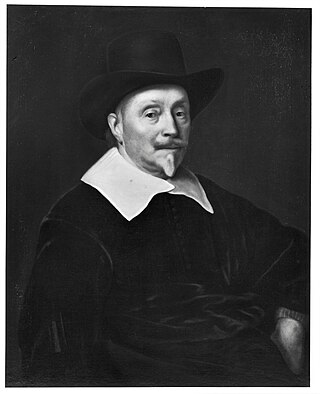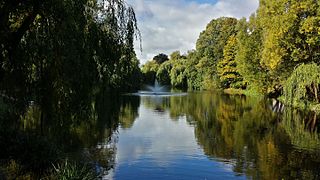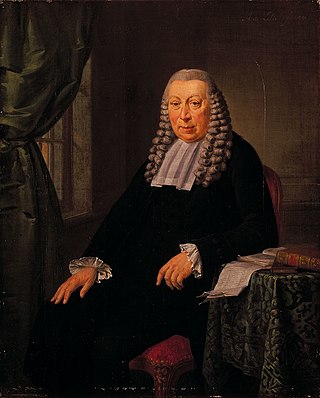Related Research Articles

Peter Stuyvesant was a Dutch colonial officer who served as the last Dutch director-general of the colony of New Netherland from 1647 until it was ceded provisionally to the English in 1664, after which it was split into New York and New Jersey with lesser territory becoming parts of other colonies, and later, states. He was a major figure in the early history of New York City and his name has been given to various landmarks and points of interest throughout the city.

The Netherlands began its colonization of the Americas with the establishment of trading posts and plantations, which preceded the much wider known colonization activities of the Dutch in Asia. While the first Dutch fort in Asia was built in 1600, the first forts and settlements along the Essequibo River in Guyana date from the 1590s. Actual colonization, with the Dutch settling in the new lands, was not as common as by other European nations.

Samuel Blommaert was a Flemish/Dutch merchant and director of the Dutch West India Company from 1622 to 1629 and again from 1636 to 1642. In the latter period, he was a paid commissioner of Sweden in the Netherlands and he played a dubious but key role in Peter Minuit's expedition that led to the Swedish colonizing of New Sweden. For years Blommaert was involved in the copper trade and industry. In 1645 he was appointed for a third time as a manager of the WIC, being one of the main investors from the beginning.

Koszalin is a city in northwestern Poland, in Western Pomerania. It is located 12 kilometres south of the Baltic Sea coast, and intersected by the river Dzierżęcinka. Koszalin is also a county-status city and capital of Koszalin County of West Pomeranian Voivodeship.

The Delaware Colony, officially known as the three "Lower Counties on the Delaware", was a semiautonomous region of the proprietary Province of Pennsylvania and a de facto British colony in North America. Although not royally sanctioned, Delaware consisted of the three counties on the west bank of the Delaware River Bay. In the early 17th century, the area was inhabited by Lenape and possibly Assateague Native American Indian tribes. The first European settlers were Swedes, who established the colony of New Sweden at Fort Christina in present-day Wilmington, Delaware, in 1638. The Dutch captured the colony in 1655 and annexed it to New Netherland to the north. Great Britain subsequently took control of it from the Dutch in 1664. In 1682, William Penn, the Quaker proprietor of the Province of Pennsylvania to the north leased the three lower counties on the Delaware River from James, the Duke of York, who went on to become King James II.
Daniel of Galicia or Danylo Romanovych was a King of Ruthenia, Prince (Kniaz) of Galicia (Halych) (1205–1255), Peremyshl (1211), and Volodymyr (1212–1231). He was crowned by a papal archbishop in Dorohochyn in 1253 as the first King of Ruthenia (Rus') (1253–1264).
Thomas Willett was a Plymouth Colony fur trader, merchant, land purchaser and developer, Captain of the Plymouth Colony militia, Magistrate of the colony, and was the 1st and 3rd Mayor of New York, prior to the consolidation of the five boroughs into the City of New York in 1898.

Jeremias van Rensselaer was the third son of Kiliaen van Rensselaer, one of the founders and directors of the Dutch West India Company who was instrumental in the establishment of New Netherland and was created the first patroon of the Manor of Rensselaerswyck. Jeremias van Rensselaer was the acting patroon of the Manor of Rensselaerswyck, and the first of his family to establish himself permanently in America.

Polish Brazilians refers to Brazilians of full or partial Polish ancestry who are aware of such ancestry and remain connected, to some degree, to Polish culture, or Polish-born people permanently residing in Brazil. Also, a Polish Brazilian may have one Polish parent.
Bastiaen Jansz Krol was Director of New Netherland from 1632 to 1633.

Fort Casimir or Fort Trinity was a Dutch fort in the seventeenth-century colony of New Netherland. It was located on a no-longer existing barrier island at the end of Chestnut Street in what is now New Castle, Delaware.

Nathaniel Batts (–1679) was a fur trader, explorer and Indian interpreter. He became the first recorded European to permanently settle in North Carolina in 1655. He often appears as Captain Nathaniel Batts in the records of Norfolk County, Virginia, where his wife owned land by her prior husband, Henry Woodhouse.

Henryk Arctowski, born Henryk Artzt, was a Polish scientist and explorer.

Augustine Herman, First Lord of Bohemia Manor was a Bohemian explorer, merchant and cartographer who lived in New Amsterdam and Cecil County, Maryland. In the employment of Cecil Calvert, 2nd Baron Baltimore, he produced a remarkably accurate map of the Chesapeake Bay and Delaware Bay regions of North America, in exchange for which he was permitted to establish an enormous plantation that he named Bohemia Manor in what is now southeastern Cecil County, Maryland.
Michael Pauluzen van der Voort - was an early resident of New Amsterdam and an early settler of Talbot County, Maryland. In New Amsterdam, in 1640, he married Marretje Maria Rapelje, whose older sister, Sarah, was the first European born in the New Netherland colony. Michael's enterprises included real estate, shipping, tavern keeping and, in Maryland, planting tobacco. Michael is the ancestor of many in the United States who spell their name Vandervoort, Vanderford, Vandeford, Vandiver, Vandevert, Vandaveer or similarly.

Samuel Godin, Godyn or Godijn was a wealthy merchant, originally from Southern Netherlands, trading on Spain, Brazil and the Levant. He was one of the administrators of the Noordsche Compagnie, involved in whaling, and of the Dutch West India Company. From 1620 he traded on New Netherland. His name was at first given to the Delaware Bay and he was one of the main investors in Zwaanendael. The colony did not last very long as it was plundered by Native Americans soon after its founding.
Nicholas Bayard was a government official and slave trader in colonial New York. Bayard served as the mayor of New York City from 1685 to 1686. He is historically most notable for being Peter Stuyvesant's nephew and for being a prominent member of the Bayard family, which remained prominent in New York City history into the 20th century.
Jacob Jacobsz Steendam was a Dutch poet and a minister. He collaborated with Pieter Corneliszoon Plockhoy.
Edward G. Pinkowski was an American writer, journalist, and historian of Polish descent. He was presented with the Polish American Historical Society's Haiman Award in 1989, and the Cavalier's Cross of the Order of Merit by the President of Poland in 2001. He turned 100 in August 2016 and died in January 2020 at the age of 103 and 5 months.

Hendrik Daniëlszoon Hooft, Ambachtsheer of Urk and Emmeloord was a Dutch politician during the Patriottentijd.
References
Notes